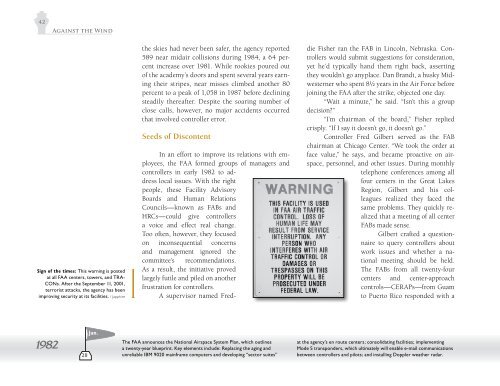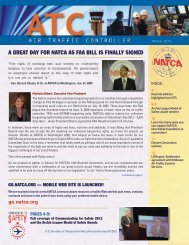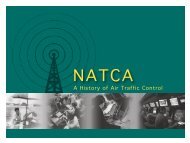Against the Wind - National Air Traffic Controllers Association
Against the Wind - National Air Traffic Controllers Association
Against the Wind - National Air Traffic Controllers Association
You also want an ePaper? Increase the reach of your titles
YUMPU automatically turns print PDFs into web optimized ePapers that Google loves.
42<br />
<strong>Against</strong> <strong>the</strong> <strong>Wind</strong><br />
Sign of <strong>the</strong> times: This warning is posted<br />
at all FAA centers, towers, and TRA-<br />
CONs. After <strong>the</strong> September 11, 2001,<br />
terrorist attacks, <strong>the</strong> agency has been<br />
improving security at its facilities. / Japphire<br />
1982<br />
28<br />
Jan.<br />
<strong>the</strong> skies had never been safer, <strong>the</strong> agency reported<br />
589 near midair collisions during 1984, a 64 percent<br />
increase over 1981. While rookies poured out<br />
of <strong>the</strong> academy’s doors and spent several years earning<br />
<strong>the</strong>ir stripes, near misses climbed ano<strong>the</strong>r 80<br />
percent to a peak of 1,058 in 1987 before declining<br />
steadily <strong>the</strong>reafter. Despite <strong>the</strong> soaring number of<br />
close calls, however, no major accidents occurred<br />
that involved controller error.<br />
Seeds of Discontent<br />
In an effort to improve its relations with employees,<br />
<strong>the</strong> FAA formed groups of managers and<br />
controllers in early 1982 to address<br />
local issues. With <strong>the</strong> right<br />
people, <strong>the</strong>se Facility Advisory<br />
Boards and Human Relations<br />
Councils—known as FABs and<br />
HRCs—could give controllers<br />
a voice and effect real change.<br />
Too often, however, <strong>the</strong>y focused<br />
on inconsequential concerns<br />
and management ignored <strong>the</strong><br />
committee’s recommendations.<br />
As a result, <strong>the</strong> initiative proved<br />
largely futile and piled on ano<strong>the</strong>r<br />
frustration for controllers.<br />
A supervisor named Fred-<br />
The FAA announces <strong>the</strong> <strong>National</strong> <strong>Air</strong>space System Plan, which outlines<br />
a twenty-year blueprint. Key elements include: Replacing <strong>the</strong> aging and<br />
unreliable IBM 9020 mainframe computers and developing “sector suites”<br />
die Fisher ran <strong>the</strong> FAB in Lincoln, Nebraska. <strong>Controllers</strong><br />
would submit suggestions for consideration,<br />
yet he’d typically hand <strong>the</strong>m right back, asserting<br />
<strong>the</strong>y wouldn’t go anyplace. Dan Brandt, a husky Midwesterner<br />
who spent 8½ years in <strong>the</strong> <strong>Air</strong> Force before<br />
joining <strong>the</strong> FAA after <strong>the</strong> strike, objected one day.<br />
“Wait a minute,” he said. “Isn’t this a group<br />
decision?”<br />
“I’m chairman of <strong>the</strong> board,” Fisher replied<br />
crisply. “If I say it doesn’t go, it doesn’t go.”<br />
Controller Fred Gilbert served as <strong>the</strong> FAB<br />
chairman at Chicago Center. “We took <strong>the</strong> order at<br />
face value,” he says, and became proactive on airspace,<br />
personnel, and o<strong>the</strong>r issues. During monthly<br />
telephone conferences among all<br />
four centers in <strong>the</strong> Great Lakes<br />
Region, Gilbert and his colleagues<br />
realized <strong>the</strong>y faced <strong>the</strong><br />
same problems. They quickly realized<br />
that a meeting of all center<br />
FABs made sense.<br />
Gilbert crafted a questionnaire<br />
to query controllers about<br />
work issues and whe<strong>the</strong>r a national<br />
meeting should be held.<br />
The FABs from all twenty-four<br />
centers and center-approach<br />
controls—CERAPs—from Guam<br />
to Puerto Rico responded with a<br />
at <strong>the</strong> agency’s en route centers; consolidating facilities; implementing<br />
Mode S transponders, which ultimately will enable e-mail communications<br />
between controllers and pilots; and installing Doppler wea<strong>the</strong>r radar.




